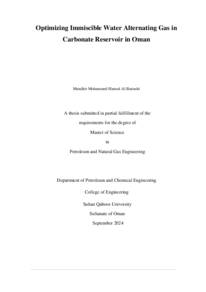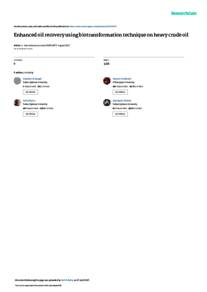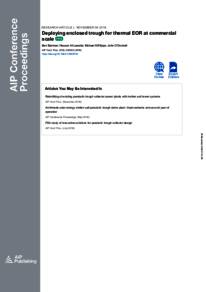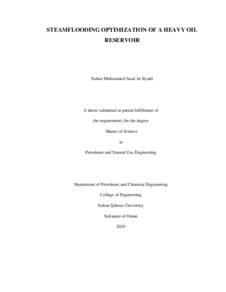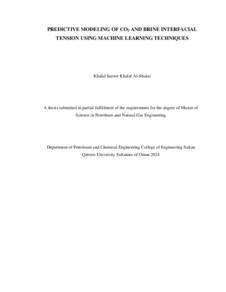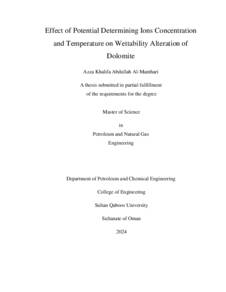Document
Optimizing immiscible water alternating gas in carbonate reservoir in Oman.
Source
Master's thesis
Other titles
تحسين حقن الغاز المتناوبة بالمياه غير القابلة للامتزاج في مكمن الكربونات في عمان
Country
Oman
City
Muscat
Publisher
Sultan Qaboos University.
Gregorian
2024
Language
English
Thesis Type
Master's thesis
English abstract
Enhanced Oil Recovery (EOR) techniques are crucial for maximizing hydrocarbon extraction from mature oil fields. Among these techniques, Water-Alternating Gas Injection (WAG) stands out as a particularly promising strategy for addressing challenges related to superseding and under-riding phenomena, especially in viscous mature oil fields. This paper explores the effectiveness of WAG injection as an EOR method, with a focus on optimizing recovery efficiency using the Cmost optimization tool (CMG).
Field-A, located in northeastern Oman, exemplifies the geological complexity typical of such fields, with its unique challenges including fractures and diverse lithology. Gas injection in Field A is particularly challenging due to these fractures and high permeability streaks, which lead to a disproportionate amount of gas relative to oil. Despite these challenges, Field-A remains integral to Oman's hydrocarbon portfolio and has undergone various development strategies, from solution drive to water flood projects. Optimizing injection techniques, especially WAG, is essential to overcoming these challenges and maximizing recovery rates.
Optimizing multi-objective function using particle swarm optimization has yielded in maximizing cumulative oil production and minimizing cumulative gas over oil ratio and minimizing cumulative water production. The optimizations were executed for bi-objective and tri-objective variables. Bi-objective optimization has resulted in a pareto solution with maximum cumulative oil rate of 133 X1000 Mm3 with cumulative gas over oil ratio of 139 mm3/mm3. In other side, tri-objective variables were conflicted and bounded by third variable which is minimizing water production. However, the result of tri-objective has shown same to bi-objective optimization.
In conclusion, this study investigates optimizing oil production through bi-objective and tri-objective approaches. The bi-objective optimization focuses on maximizing cumulative oil production and minimizing the gas-oil ratio, significantly improving oil production and efficiency compared to the base case. The tri-objective optimization, which includes minimizing cumulative water production, results in more dispersed solutions, offering a broader range of operational options. Adjustments in gas and water injection rates are crucial in achieving these optimized outcomes. The study demonstrates substantial improvements in reservoir performance through strategic optimization, providing valuable insights for enhanced oil recovery strategies.
Arabic abstract
تلعب تقنيات الاستخلاص المعزز للنفط (EOR) دورًا محوريًا في تعظيم استخراج الهيدروكربون من حقول النفط الناضجة. ومن بين هذه التقنيات، يبرز حقن الغاز المتناوب بالماء (WAG) كاستراتيجية واعدة لمواجهة التحديات المرتبطة بظواهر الاستبدال أو النقص، خاصة في حقول النفط الناضجة اللزجة. لذلك، تقدم هذه الورقة استكشافًا شاملاً لحقن WAG كأحد أساليب الاستخلاص المعزز للنفط، مع التركيز على فعاليته في تعزيز كفاءة الاسترداد باستخدام أداة التحسين Cmost (CMG). تسلط الدراسات الحديثة الضوء على إنتاجية الإزاحة الحجمية وإمكانية استخلاص النفط من حقن WAG خاصة، في حقول النفط الناضجة. ويجسد الحقل (أ)، الذي يقع في شمال شرق عمان، التعقيد الجيولوجي الكامن في مثل هذه الحقول. يمثل التعقيد الجيولوجي عقبات فريدة من نوعها، بما في ذلك الكسور والخصائص الصخرية المتنوعة. يواجه حقن الغاز للحقل (أ) تحديات بسبب الكسور والشرائط عالية النفاذية، مما يؤدي إلى أحجام غاز غير متناسبة مقارنة بالنفط. ومع ذلك، يظل الحقل (أ) جزءًا لا يتجزأ من محفظة النفط والغاز في سلطنة عمان، ويخضع لاستراتيجيات تطوير مختلفة بدءًا من الحلول إلى مشاريع فيضانات المياه. يعد تحسين تقنيات الحقن، وخاصة WAG، أمرًا بالغ الأهمية للتغلب على التحديات وتعظيم معدلات الاسترداد. أسفرت عملية تحسين الوظيفة متعددة الأهداف باستخدام تحسين سرب الجسيمات عن زيادة إنتاج النفط التراكمي وتقليل نسبة الغاز التراكمي إلى الزيت وتقليل إنتاج الماء التراكمي. تم تنفيذ التحسينات للمتغيرات ثنائية الهدف وثلاثية الهدف. أدى التحسين ثنائي الهدف إلى الحصول على حلول باريتو مع الحد الأقصى لمعدل الزيت التراكمي مع نسبة تراكمية للغاز إلى الزيت تبلغ 133x1000 Mm3 و 139 Mm3/MM3 على التوالي. وفي الجانب الآخر، كانت المتغيرات الثلاثية متعارضة ويحدها المتغير الثالث وهو تقليل إنتاج المياه. ومع ذلك، فقد أظهرت نتيجة الهدف الثلاثي نفس الشيء بالنسبة للتحسين ثنائي الهدف. في الختام، تبحث هذه الدراسة في تحسين إنتاج النفط من خلال نهج ثنائي الهدف وثلاثي الهدف. يركز التحسين ثنائي الهدف على زيادة إنتاج النفط التراكمي إلى الحد الأقصى وتقليل نسبة الغاز إلى الزيت، مما يؤدي إلى تحسين إنتاج النفط وكفاءته بشكل كبير مقارنة بالحالة الأساسية. يؤدي التحسين ثلاثي الأهداف، والذي يتضمن تقليل إنتاج المياه التراكمي، إلى حلول أكثر تشتتاً، مما يوفر نطاقًا أوسع من الخيارات التشغيلية. تعد التعديلات في معدلات حقن الغاز والماء أمرًا بالغ الأهمية لتحقيق هذه النتائج المحسنة. وتوضح الدراسة تحسينات كبيرة في أداء الخزان من خلال التحسين الاستراتيجي، مما يوفر رؤى قيمة لاستراتيجيات الاستخلاص المعزز للنفط.
Category
Theses and Dissertations

